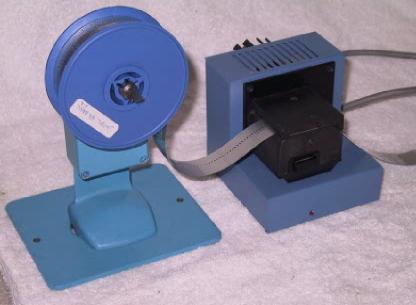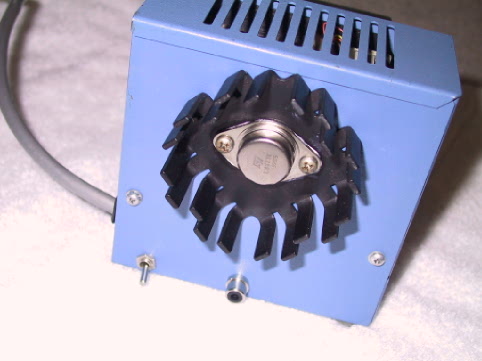
Punched (Paper) Tape
Paper tape was an early format for the storage of programs and data,
using a technology dating back quite a bit. The earliest "program storage facility" according to some
historians, was a set of punched cards used by a French weaving machine used to generate certain types of patterns.
Changing the cards would change the pattern, which was much easier than essentially rebuilding the entire weaving
machine. From this grew the punched cards of the early 1900's, and soon thereafter, the five-level paper tape.
Later, eight level paper tape was introduced with ASCII.
Reading paper tape in principle is much like operating a music box. A punched hole represents a one and a lack
of a hole represents a zero. The smaller holes are used by a sprocket to pull the tape and keep the reading timing
in line.
Early paper tape punches required oiled tape, which was very messy. Later high precision, high-strength carbon
steel dies didn't require oil. The tape was delicate and could not be read an infinite number of times. More expensive
Mylar tape was later developed which was much sturdier. Only some "modern" (1970-1990+) punches are capable
of punching Mylar. In a way, Mylar paper tape might be the closest thing to a truly archival digital storage medium
there is; if stored in a dry and cool place, it should be usable for an extremely long time, and its row-byte pattern
is visually obvious and easily decoded with equipment that could reasonably expected to be available hundreds or
thousands of years from now. More "modern" magnetic media and even CD-ROMS will definitely not survive
this length of time.
Paper tape was provided and stored "folded", or on a roll. The folded paper variety was, of course, more
subject to breakage but had storage advantages. Paper tape patches were available.
Even after the use of paper tape in large-scale computers died out by the late 60's, it was still used with mini
and micro based general purpose computing till at least the late 1970's, mostly because of the popularity of the
ASR-33 Teletype machine, which had a built in punch and reader. Hard for me to believe, this is how I cut my teeth
on computing almost 30 years ago! I can still smell the hot motor oil of the Teletype...
Paper tape survives to this day to a degree for use with CNC type machines in machine shops, particularly in underdeveloped
countries where they have been "handed down" from the industrialized world as we have gone on to more
sophisticated machines and controllers.
I wanted to have authentic technology peripherals for my classic computers, so I developed a punched tape infrastructure by acquiring some readers and punches.
General Electric/Decitek Paper Tape Reader
This paper tape reader, originally in a very nice portable case, was designed to work with CNC equipment (see Figure
1). Paper tape was (and is, in underdeveloped countries) used with CNC equipment long after its use was discontinued
with general-purpose computers. Magnetic tape, solid-state, or PC-based replacements exist as retrofits for CNC
machines. This reader is almost purely optical and can read at 400 characters per second! It can spool tape over
the read head for longer programs or step tape through the printhead at a slower speed. It is also somewhat better
capable of dealing with damaged or worn tape than are my other readers. The manual, while still available, (and
a unit similar to this is STILL in production), is $75.00, so I figured out enough of it to get it working at 4800
(7,e,1) baud. However, I believe that it is capable of start/stop reading down to much slower baud rates. The inability
to read the eighth bit (because of a lack of documentation, and probably not a limitation of the unit) means that
I can't use this to load binary tapes. The good news is that the unit is so fast that the longer lengths of these
tapes (Intel hex or Motorola .S19) is unimportant. It is also extremely fun to watch. The quality of the construction
of this unit is awesome, especially if you've been looking at modern PC stuff, which isn't built to last. This
unit is built to be maintainable for decades.
.

Figure 1. GE/Decitek Paper Tape Reader/Spooler W/SWTPC 4K BASIC Tape
DATA I/O Paper Tape Reader
This reader was originally designed to work with an expensive EPROM programmer, and is of late 70's-early 80's
vintage (this one was built on February 4, 1982). It was actually powered through a trick RS-232 connection on
the main DATA I/O system 19 programmer. The unit required +24 for the stepper, +5 for logic, and -5 for the RS-232.
I repurposed the tape reader by adding a +5 volt LM323K regulator as well as an internal DC/DC converter and regulator
for -5 volts to it; therefore, it is powered directly by 24 volts only from an external source. The result is not
particularly power efficient, but it is neat. The modifications wouldn't prevent the unit from operating with a
DATA I/O programmer, because the I/O is intact. The external power supply, however, would be needed. I also added
a small LED "power on" lamp on the front and a power switch on the rear.
This is an extremely well made unit, with two interesting characteristics; firstly, it can read 5,6, or 8 level
paper tape without changing any reader parts due to a selectable guide in the read head; secondly, the unit doesn't
use a microprocessor, it uses TTL logic, a dual-baud rate crystal hybrid module, and a TTL PROM as sort of a microcoded
controller. It is very compact (except for the external power supply). As seen in Figure 2, it is being fed by
a hand winder. Figure 3 shows the external modifications. So, I suppose I mangled a "classic" piece of
hardware a bit, but it does work well.
I didn't have any specs or pinouts for the unit, so it took a bit of reverse engineering in order to power it and
to communicate with it. The RS-232 output wound up to be at 2400,n,8,2 (weird!). An RS-232 handshaking line turns
the reader on and off instantaneously. It looks like it reads about 100 CPS.

Figure 2. Modified Data I/O 950-1950 PTR W/Western Numerical Control
Winder

Figure 3. Detail of Data I/O PTR Switch, HS/Regulator, and Power Input Modifications
DSI Paper Tape Punch/Reader
This unit (see Figure 4) is of mid 80's vintage design and by
then was primarily sold to machine shops who used it for CNC equipment. It has a serial 110/300 baud interface
and is capable of punching and copying paper or Mylar tape (which I prefer to use because of its durability). I
use Mylar for irreplaceable software, because the tape is quite expensive compared to paper tape. Generally, I
punch only important demonstration software with it, because this machine is somewhat irreplaceable at a price
that I can afford, and I suspect that the manufacturer is out of business; spare parts are "fuggetaboudit".
This unit was a lower-end punch in its era and I don't think it can stand up to extremely rigorous use, and I don't
know much about its previous life. Rebuilt, this punch still commands $1500 dollars in the CNC marketplace. Fortunately,
I purchased a punch-only unit, which, while working, will provide spare parts should this one fail. I made a spindle
and chad box for it, because they were missing. I had to replace the belts and make some significant adjustments
to its mechanisms. It doesn't look too good, but it works very well!
With no documentation, I had to hunt a bit to get these to work. While testing, I wrote a trivial VB program to
print letters on the tape in a 5x7 matrix. I also wrote programs to turn binary files into Intel hex. I have yet
to get the reader to read to RS-232, but I suspect that this is a handshaking problem.
.

Figure 4. DSI Paper Tape Punch/Reader (Obviously Mylar Capable)

Figure 5. DSI Paper Tape Punch, Punching Folded Tape (Dog Fur Not Part Of Unit)